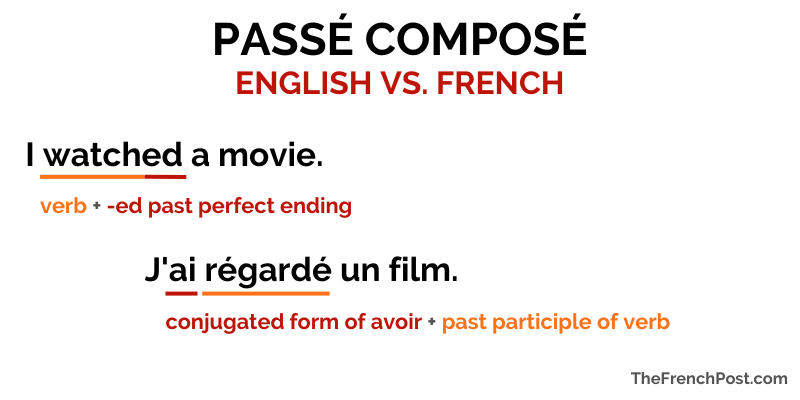
The French passé composé tense, or past perfect tense, is the most common tense for talking about the past. It’s used for talking about specific events that occurred in the past. (The other common past verb tense is the imparfait, which we discuss here, is used for more general and ongoing past actions.) We also have a general overview of how to talk about the past in French.
How to form the French Passé Composé
In English, the past perfect tense is a single word. For regular verbs, you form it by taking the root verb and adding “-ed” to the end of it (like in “typed”, “talked”, “danced”, etc).
Passé composé in French is a compound, or two-part verb tense. To from it, you need 1) a helping verb that is conjugated based on the subject of the sentence, and 2) the past participle of the verb (we’ll walk you through what past participles are, too, if you aren’t already familiar with them).

In other words, the Past Perfect Tense = Helping Verb + Past Participle
Step 1: Use the French Passé Composé Helping Verb: Avoir or Être
The helping verb used for almost all verbs is the present tense conjugation of avoir for whatever the subject/subject pronoun of the sentence is. For about a dozen verbs, you will use the present tense of être as the helping verb instead. We discuss those verbs later on in this lesson, or you can read about them directly here.
But for most verbs, you will use the avoir conjugation to create the helping verb:
| j’ai | nous avons |
| tu as | vous avez |
| il/elle a | ils/elles ont |
Step 2: Form the Past Participle
The second step is to form the past participle, which is a special form of the verb of the sentence. Its form will not change, no matter what the conjugation of the helping verb is. Most follow set patterns, but a few are irregular and must be memorized. These past participles are identical to what you will use in the plus-que-parfait past tense, as well.
Regular Past Participles
Regular past participles follow set patterns based on whether they are –er, –ir, or –re verbs. For each one, start with the infinitive form, then change the verb endings as described below.
–ER Verbs
For regular –er verbs, drop the –er from the infinitive and add é.
Example with manger: Tu manges (present tense) → Tu as mangé (passé composé)
–IR Verbs
For regular –ir verbs, drop the –ir from the infinitive and add i.
Example with choisir: Il choisit (present tense) → Il a choisi (passé composé)
–RE Verbs
For regular –re verbs, drop the –re from the infinitive and add u.
Example with vendre: Vous vendez (present tense) → Vous avez vendu (passé composé)
Irregular Past Participles
Just like most other verb forms, the French perfect tense conjugations of certain common verbs are irregular. Many fall into recognizable groups based on their endings. For example:
Rire: Je ris → j’ai ri and Sourire: je souris → J’ai souri
Ouvrir: J’ouvre → j’ai ouvert and Couvrir: je couvre → J’ai couvert
Here are the most common irregular past participles to learn:
| Verb Form | Past Participle |
| avoir | eu |
| être | été |
| dire | dit |
| écrire | écrit |
| faire | fait |
| rire | rit |
| tenir | tenu |
| ouvrir | ouvert |
| couvrir | couvert |
| connaître | connu |
| rire | ri |
| sourire | souri |
| boire | bu |
| croire | cru |
| prendre | pris |
| mettre | mis |
| vivre | vécu |
| boire | bu |
| croire | cru |
Here are a few French passé composé examples with irregular past participles so you can see them in action:
Je l’ai cru un instant. (“I believed him for a moment.”)
Nous avons bu toute la carafe. (“I drank the entire carafe.”)
Tu as fait une erreur. (“I made a mistake.”)
The exceptions: The French passé composé verbs that are conjugated with ÊTRE as the helping verb
Okay, once you have all that down, are you ready to be thoroughly confused? You may have noticed that some important verbs are missing from our list up there. Most noticeably, there’s no aller, one of our fundamental verbs, on that list.
Why not? Because a select few verbs get conjugated with être instead of avoir. It’s a limited list, don’t worry, but some vital verbs you should learn are on that list.
To make sense of past tense in French, think of the avoir conjugation in this lesson as the general rule. The vast majority of verbs will follow it, and if you see a verb that’s not on the list in the next lesson, the method in this lesson is how you should conjugate it.
Next Steps
This lesson moves directly into the lesson on the “exception” passé composé verbs, which have a couple additional quirks to consider when you conjugate them. You might also want to read about the imparfait past tense or the plus-que-parfait past tense.



